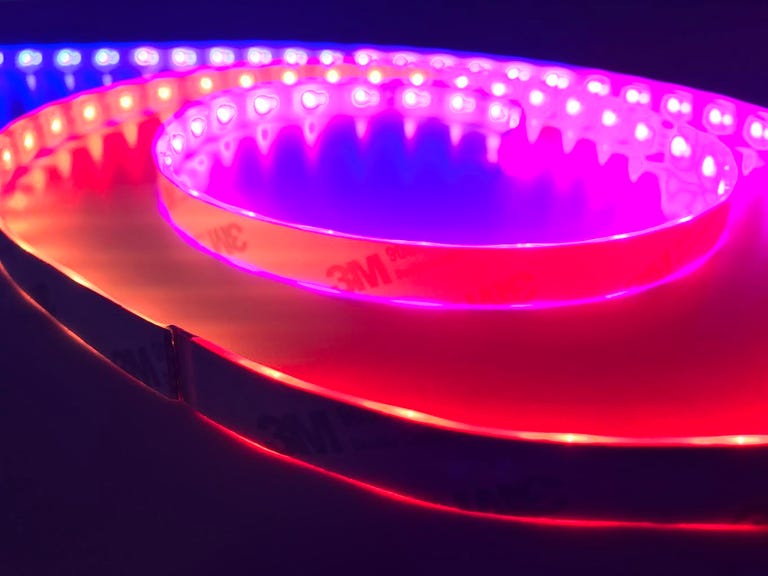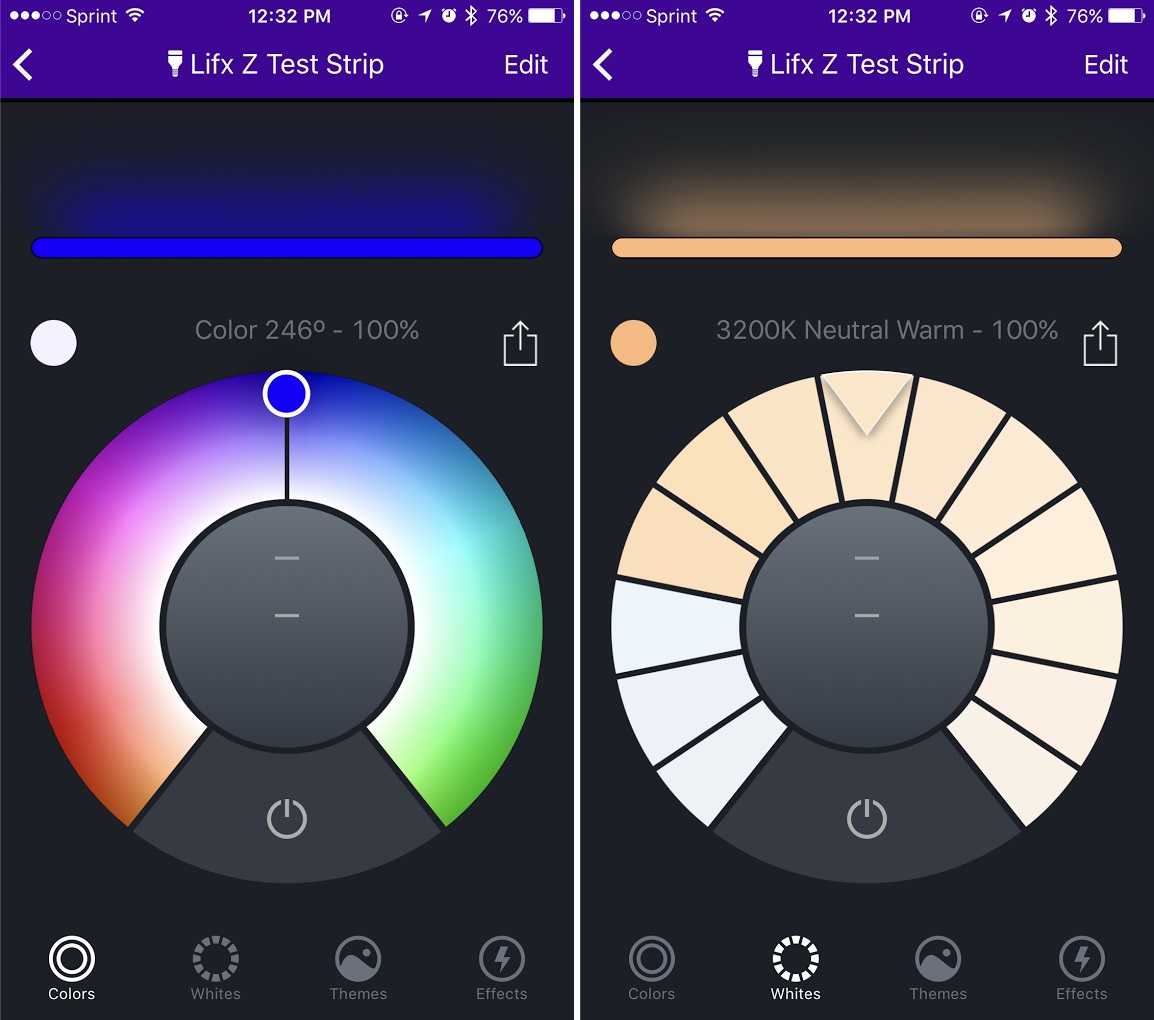 Why You Can Trust CNET
Why You Can Trust CNET Lifx Z Multi-Color LED Wi-Fi Light Strip review: Plenty of potential from the Lifx Z multicolor light strip
The new LED light strips from Lifx don't need a hub and let you "paint" whatever colors you like onto the strips -- two potential advantages over the competing strip lights from Philips.
Lifx is a top option in the color-changing smart bulb category, but it's never offered color-changing light strips like the ones you'll find from Philips Hue or Osram Lightify. That changed recently when Lifx introduced "Lifx Z," a set of multicolor LED strips that you can stick up under cabinets or behind your TV set. They connect directly to your router using Wi-Fi just like Lifx lightbulbs do, and even let you "paint" each strip with multiple colors -- something you can't do with Philips or Osram.
The Good
The Bad
The Bottom Line
The starter kit comes with two 1-meter strips and the plug-in power supply for $90 (about £70/AU$120), with additional 1-meter strips selling for $30 (£25/AU$40). While Osram's starter kit is slightly cheaper, Lifx's pricing matches what you'll find with Philips Hue. That makes Lifx Z a viable alternative if you're in the market for RGB smart strips, especially since they don't need any sort of hub or bridge plugged into your router in order to connect with your network.
You can change the color or color temperature of the light strips in the Lifx app, just like you can with Lifx smart bulbs.
Getting started with the Lifx Z strips is pretty simple. Connect your strips together and then connect them to the power adapter and plug them in (it can manage up to 10 strips in total). The Lifx app will direct you to connect to the Wi-Fi signal they're broadcasting -- once you do, it'll connect them with your home network and you'll be all set.
The strips have a layer of 3M sticky tape on the back -- just peel and stick to put them in place. I had them up and running under a cabinet at CNET Appliances HQ in just a few minutes; my only concern is that it might be a bit of a pain if you ever want to relocate them to another spot.
You can use the Lifx app to change the color of the strips (or the color temperature, if you're sticking with natural white light tones). The app treats them like another bulb, so if you want to group them with other Lifx products or include them in any of your scenes, you can.
Tapping one of the themes -- in this instance, "Exciting" -- will change each of the eight "zones" of lights in each one-meter strip to a random color from the theme's group.
The one in-app difference with the strips is that you'll notice a horizontal line up above the color wheel. That line shows you the current color of your strips as you rotate the dial -- but its true function comes to light once you tap over into the "Themes" section of the app.
Lifx themes are really just thematic groups of colors. Tap on one of those themes -- "Exciting," "Intense" and "Hanukkah" being just a few examples -- and your selected lights will all change to random colors from that group. It's not terribly useful if you're only controlling one bulb, but with Lifx Z, you're actually controlling multiple "zones" of lights -- eight for each one-meter strip in your setup. Tap a theme, and each zone will switch to a random color, which really heightens the effect.
The app also lets you "paint" your own colors directly onto the strips.
The real novelty here is that you can also "paint" whatever colors you want onto the strips. Just select a color from the top of the themes tab and drag it over the horizontal line representing your strips. The app will apply that color to whatever section of the strip you drag it over top of, and even blend the adjacent zones together with transitional shades. It's a downright cool feature -- and something that you can't do with Philips Hue's light strips.
It isn't perfect, though. The controls are fairly imprecise, which stems largely from the fact that the "brush" you're painting with is a relatively gigantic circle. On top of that, the more strips you've got connected, the more zones are squeezed into that horizontal line in the app. Your targets get smaller and smaller, but your brush stays just as fat.
Another big problem: there's no way to save any of your custom color patterns, nor can you create your own color themes. The best you can do is to to save your light strips as part of a scene, but if you activate that scene, the strips won't return to your pattern -- they'll just pick the dominant color from the pattern and apply it across the board.
Outside of the app, you'll enjoy all of the same third-party integrations as the rest of the Lifx lineup. You can use the free online automation service IFTTT to trigger lighting changes using any number of IFTTT-compatible products and services. You can add the light strips to a SmartThings connected home setup. You can sync the light strips with an Amazon Echo or Amazon Echo Dot smart speaker for voice control via Alexa, Amazon's virtual voice assistant. In other words, you've got plenty of options for making Lifx Z a part of a larger ecosystem of smart home gadgets.
The verdict
Color-changing lighting is a smart-home novelty, but it's a fun one, and Lifx Z's $90 starter kit leans on that fun by giving you greater control over the colors it puts out than you'll get with Philips Hue or Osram. Given that the three are comparably priced, and that Lifx Z doesn't need a hub or a bridge plugged into your router, I think it's definitely worth a look.
Still, I wish the features were a bit more refined. More precise control over each zone of lights would be a good start -- even better would be some sort of way to program your own animated light patterns. And Apple users will be disappointed to hear that Lifx products, including Lifx Z, still don't work with Apple HomeKit, the set of iOS-based smart-home protocols that let gadgets work with Siri. I see a lot of potential with this product, but I wouldn't blame anyone who wanted to wait.



